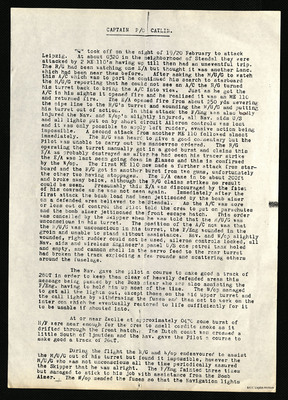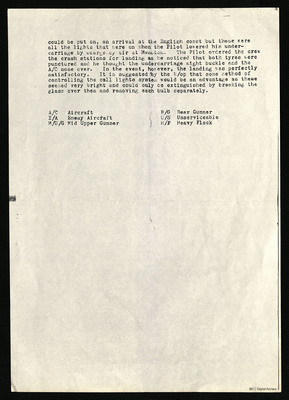Captain's account of operation to Leipzig in February 1944
Title
Captain's account of operation to Leipzig in February 1944
Description
Tells of engagement by enemy Me-110s in area of Stendal when the flight engineer, mid upper gunner, navigator and wireless operator were wounded. The aircraft suffered damaged and suffered further attacks but one enemy fighter was probably destroyed. Continues with account of return trip including that the flight engineer fainted three times but continued to perform his duties. The aircraft landed safely at Manston.
Creator
Language
Format
Two page typewritten document
Publisher
Rights
This content is available under a CC BY-NC 4.0 International license (Creative Commons Attribution-NonCommercial 4.0). It has been published ‘as is’ and may contain inaccuracies or culturally inappropriate references that do not necessarily reflect the official policy or position of the University of Lincoln or the International Bomber Command Centre. For more information, visit https://creativecommons.org/licenses/by-nc/4.0/ and https://ibccdigitalarchive.lincoln.ac.uk/omeka/legal.
Contributor
Identifier
SWrightBC1627924v10004
Transcription
[underlined] CAPTAIN P/O CATLIN. [/underlined]
“Q” took off on the night of 19/20 February to attack Leipzig. At about 0320 in the neighborhood [sic] of Stendal they were attacked by 2 ME 110’s having up till then had an uneventful trip. The R/G had been watching one E/A but thought it was another Lanc. which had been near them before. After asking the M/U/G to watch this A/C which was to port he continued his search to starboard the M/U/G reporting that he could not see an A/C the R/G turned his turret back to bring the A/C into view. Just as he got the A/C in his sights it opened fire and he realised it was an ME 110 and returned fire. The E/A opened fire from about 250 yds severing the pipe line to the R/G’s turret and wounding the M/U/G and putting his turret out of action. In this attack the F/Eng was also badly injured the Nav. and W/op’s slightly injured, all Nav. aids U/S and all lights put on by short circuit Aileron controls was lost and it was only possible to apply left rudder, evasive action being impossible. A second attack from another ME 110 followed almost immediately. The R/G was heard to give a good commentary but the Pilot was unable to carry out the manoevres [sic] ordered. The R/G operating the turret manually got in a good burst and claims this E/A as probably destroyed as after he had seen his tracer strike the E/A was last seen going down in flames and this is confirmed by the W/op. The first ME 110 now made a further attack from starboard and the R/G got in another burst from two guns, unfortunately the other two having stoppages. The E/A came in to about 200 ft and broke away below, although the R/G claims strikes no result could be seen. Presumably this E/A was discouraged by the fate of his comrade as he was not seen again. Immediately after the first attack the bomb load had been jettisoned by the bomb aimer on a defended area believed to be Stendal. As the A/C was more or less out of control the Pilot told the crew to put on parachutes and the bomb aimer jettisoned the front escape hatch. This order was cancelled by the Skipper when he was told that the M/U/G was unconscious in his turret. The position of the A/C now was that the M/U/G was unconscious in his turret, the F/Eng wounded in the groin and unable to stand without assistance. Nav. and W/op slightly wounded, right rudder could not be used, aileron controls locked, all Nav. aids and wireless Engineer’s panel U/S one petrol tank holed and empty, and cannon shell in the servo feed to the rear turret had broken the track exploding a few rounds and scattering others around the fuselage.
The Nav. gave the pilot a course to make good a track of 280T in order to keep them clear of heavily defended areas this message being passed by the Bomb aimer who was also assisting the F/Eng. having to hold him up most of the time. The W/op managed to get all the lights out, except those on the Mid upper turret and the call lights by withdrawing the fuses and then set to work on the inter com which he eventually restored to life sufficiently for it to be usable if shouted into.
At or near Zwolle at approximately 0430 some burst of H/F were near enough for the crew to smell cordite smoke as it drifted through the front hatch. The Dutch coast was crossed a little South of Ijmuiden and the Nav. gave the Pilot a course to make good a track of 260T.
During the flight the R/G and W/op endeavoured to assist the M/U/G out of his turret but found it impossible, however the M/U/G who was not unconscious all the time periodically assured the Skipper that he was alright. The F/Eng fainted three times but managed to stick to his job with assistance from the Bomb Aimer. The W/op mended the fuses so that the Navigation lights
[page break]
could be put on, on arrival at the English coast but these were all the lights that were on when the Pilot lowered his undercarriage by emergency air at Manston. The Pilot ordered the crew the crash stations for landing as he noticed that both tyres were punctured and he thought the undercarriage might buckle and the A/C nose over. In the event, however, the landing was perfectly satisfactory. It is suggested by the W/op that some method of controlling the call lights system would be an advantage as these seemed very bright and could only be extinguished by breaking the glass over them and removing each bulb separately.
A/C Aircraft
R/G Rear Gunner
E/A Enemy Aircraft
U/S Unserviceable
M/U/G Mid Upper Gunner
H/F Heavy Flak
“Q” took off on the night of 19/20 February to attack Leipzig. At about 0320 in the neighborhood [sic] of Stendal they were attacked by 2 ME 110’s having up till then had an uneventful trip. The R/G had been watching one E/A but thought it was another Lanc. which had been near them before. After asking the M/U/G to watch this A/C which was to port he continued his search to starboard the M/U/G reporting that he could not see an A/C the R/G turned his turret back to bring the A/C into view. Just as he got the A/C in his sights it opened fire and he realised it was an ME 110 and returned fire. The E/A opened fire from about 250 yds severing the pipe line to the R/G’s turret and wounding the M/U/G and putting his turret out of action. In this attack the F/Eng was also badly injured the Nav. and W/op’s slightly injured, all Nav. aids U/S and all lights put on by short circuit Aileron controls was lost and it was only possible to apply left rudder, evasive action being impossible. A second attack from another ME 110 followed almost immediately. The R/G was heard to give a good commentary but the Pilot was unable to carry out the manoevres [sic] ordered. The R/G operating the turret manually got in a good burst and claims this E/A as probably destroyed as after he had seen his tracer strike the E/A was last seen going down in flames and this is confirmed by the W/op. The first ME 110 now made a further attack from starboard and the R/G got in another burst from two guns, unfortunately the other two having stoppages. The E/A came in to about 200 ft and broke away below, although the R/G claims strikes no result could be seen. Presumably this E/A was discouraged by the fate of his comrade as he was not seen again. Immediately after the first attack the bomb load had been jettisoned by the bomb aimer on a defended area believed to be Stendal. As the A/C was more or less out of control the Pilot told the crew to put on parachutes and the bomb aimer jettisoned the front escape hatch. This order was cancelled by the Skipper when he was told that the M/U/G was unconscious in his turret. The position of the A/C now was that the M/U/G was unconscious in his turret, the F/Eng wounded in the groin and unable to stand without assistance. Nav. and W/op slightly wounded, right rudder could not be used, aileron controls locked, all Nav. aids and wireless Engineer’s panel U/S one petrol tank holed and empty, and cannon shell in the servo feed to the rear turret had broken the track exploding a few rounds and scattering others around the fuselage.
The Nav. gave the pilot a course to make good a track of 280T in order to keep them clear of heavily defended areas this message being passed by the Bomb aimer who was also assisting the F/Eng. having to hold him up most of the time. The W/op managed to get all the lights out, except those on the Mid upper turret and the call lights by withdrawing the fuses and then set to work on the inter com which he eventually restored to life sufficiently for it to be usable if shouted into.
At or near Zwolle at approximately 0430 some burst of H/F were near enough for the crew to smell cordite smoke as it drifted through the front hatch. The Dutch coast was crossed a little South of Ijmuiden and the Nav. gave the Pilot a course to make good a track of 260T.
During the flight the R/G and W/op endeavoured to assist the M/U/G out of his turret but found it impossible, however the M/U/G who was not unconscious all the time periodically assured the Skipper that he was alright. The F/Eng fainted three times but managed to stick to his job with assistance from the Bomb Aimer. The W/op mended the fuses so that the Navigation lights
[page break]
could be put on, on arrival at the English coast but these were all the lights that were on when the Pilot lowered his undercarriage by emergency air at Manston. The Pilot ordered the crew the crash stations for landing as he noticed that both tyres were punctured and he thought the undercarriage might buckle and the A/C nose over. In the event, however, the landing was perfectly satisfactory. It is suggested by the W/op that some method of controlling the call lights system would be an advantage as these seemed very bright and could only be extinguished by breaking the glass over them and removing each bulb separately.
A/C Aircraft
R/G Rear Gunner
E/A Enemy Aircraft
U/S Unserviceable
M/U/G Mid Upper Gunner
H/F Heavy Flak
Collection
Citation
J H Catlin, “Captain's account of operation to Leipzig in February 1944,” IBCC Digital Archive, accessed November 7, 2024, https://ibccdigitalarchive.lincoln.ac.uk/omeka/collections/document/26765.
Item Relations
This item has no relations.


